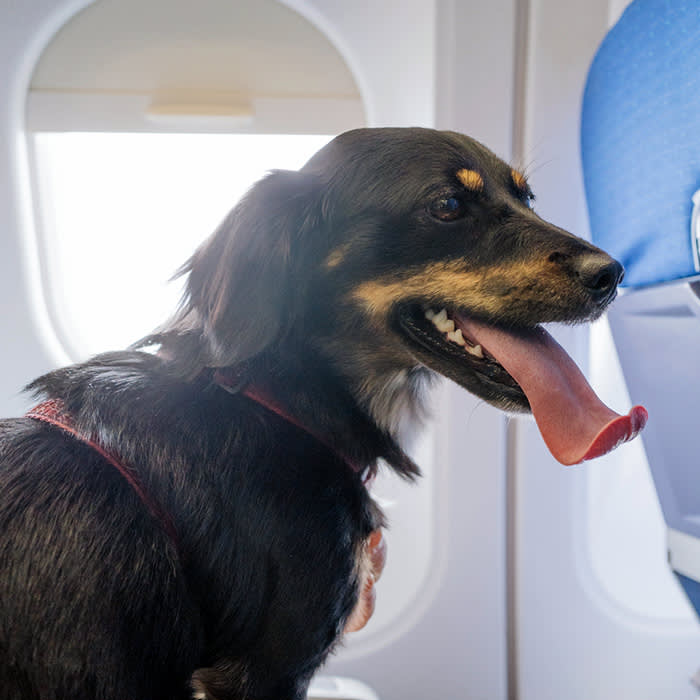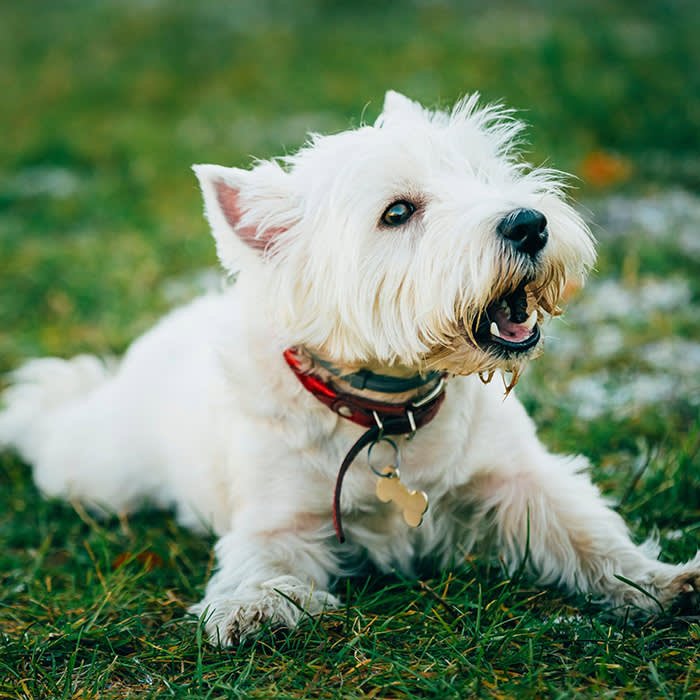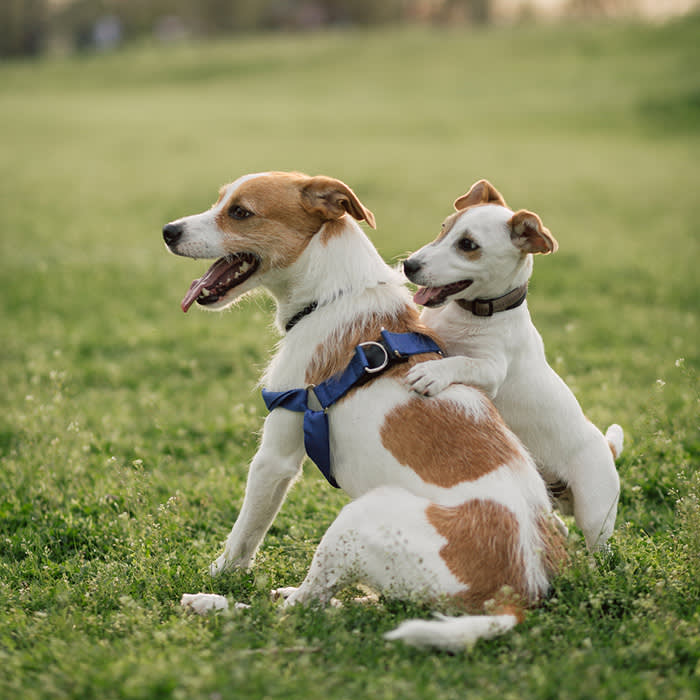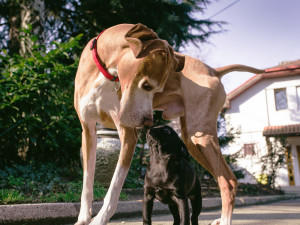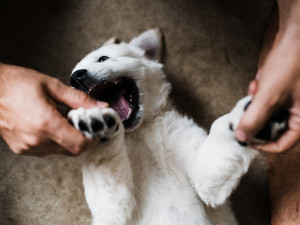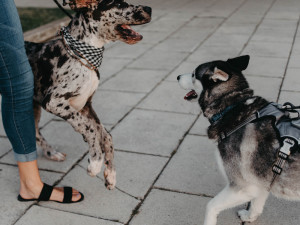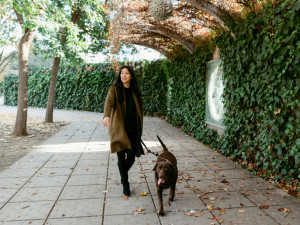9 Reasons Why Dogs Put Their Ears Back
Here‘s how your dog’s ears can clue you into how they’re feeling

share article
In this article:
Why dogs pull ears backopens in a new tab Emotional signallingopens in a new tab Other dog body languageopens in a new tab
The eyes may be the mirror to a dog’s soul, and careful observations of both the mouth and the tail can yield all sorts of information about a dog’s intentions and emotional state – but a dog’s earsopens in a new tab are a more complicated matter. Dog ears are more challenging to read and understand and they usually have to be assessed in conjunction with other visual signals to make a useful interpretation. That is especially true when the dog’s ears are pulled back or held close to the head because dogs pin their ears back for many reasons.
As a general rule, a dog’s level of attention can be determined by watching their ears: erect ears facing forward indicate that they’re engaged, and slightly pulled-back ears signal that they’re feeling friendly, but dog ears pinned tightly back against the head suggest a fearful or timid reaction.
Why do dogs pull their ears back?
While the act of pulling ears back is easily observable, interpreting its meaning requires a nuanced understanding of the context as well as dog behaviour and emotions. While a dog’s eyes, mouth and tail can provide information about their feelings, understanding their ears requires consideration of other visual cues. Reasons a dog may pull their ears back include sadness, fear, anxiety, appeasement, danger, courting, pain, listening or natural positioning. So, if you are wondering, “Why are my dog’s ears back?” consider the context and other visual signals in your dog.
The emotional signals your dog’s ears are sending you
What does it mean when a dog’s ears are back? Dog ears that are tucked close to the head often indicate negative emotions. Here are the common reasons why dogs pull their ears back, most of which are linked to their emotional state.
Sadness
One possibility is sadnessopens in a new tab, which often results in ears that are tucked down close to the sides of the head. Dogs may show this when a favourite person departs. I once saw a dog pull his ears back like this when he saw some of his pup friends playing but he couldn’t join them because he was on a lead.
Fear
Dog ears that are pulled back can often indicate fearfulnessopens in a new tab. This is especially true if combined with other facial and body signals associated with this emotion. You can assess a dog’s fearfulness by their lowered body posture, lowered tail, ears back, panting, yawning, lip-licking, avoiding eye contact and attempts to hide, escape or retreat. It’s important to note that all dogs express fear differently and they may only show some of these signs. Some dogs also show this stiffness of the tail or body, trembling, furrowed brow, whale eye (when a dog moves their eyes but not their head, so you can see the whites of their eyes), squinting, dilated pupils or pulling the corners of the lips back.
Anxiety
Sometimes dogs put their ears back when they are nervous or anxiousopens in a new tab and this will often be combined with other body language such as tongue flicks, panting, tension in the body, or other signs of anxiety. This is a common behaviour in dogs who must be in the car but dislike being driven around, or dogs who are overwhelmed by too many children at once. You might also find your dog doing this when you are stroking themopens in a new tab, which indicates they aren’t enjoying themselves.
Appeasement
When a dog’s ears are in their natural resting position, it typically indicates that a dog is comfortable in the situation. When dogs greet each otheropens in a new tab however, it is common to see one dog maintain their natural ear posture, suggesting that they are at ease, while another dog puts their ears back, indicating the opposite. Putting the ears back in this context may be an appeasement behaviour.
Danger
Dogs who are about to bite often pin their ears tightly to the head. It has been suggested that this may simply protect their ears from injury by keeping them out of the way of any teeth in the vicinity. This would be combined with other body language as a warning sign, including growlingopens in a new tab, barkingopens in a new tab, lunging, tooth displaying, going stiff, tongue flicking, charging, hard stares and facial expressions indicating nervousness or fearfulness (see above).
Courting
Males will pull their ears back when they are courting a female, and this body language is one of many forms of expression that indicates he is interested in her.
Pain from injury or otherwise feeling unwell
When dogs are in painopens in a new tab because of illness or injury, they sometimes hold their ears back. This may indicate sadness due to feeling unwell or fear of further pain. The pain or discomfort can be anywhere in the body, though in some cases, the dog may actually be holding painful ears in the position that feels most comfortable.
Listening
Dogs sometimes pull one or more ears back to listen better, especially to sounds coming from behind them. Dogs have much more control over the position of their ears than people because of the many muscles that control ear movement. Swiveling their ears helps them locate the location of the source of any noise they hear.
Natural position
Dogs of different types have all kinds of ears, just like there is incredible variation in their tails, faces, size, and overall body shapes. In contrast to the pricked-up ears of the foxy and Northern breeds or the long hanging ears so common in scent hounds, there are dogs whose ears are naturally in a pulled-back position. So, one reason you may see a dog and observe that their ears are pulled back (but not pinned against their head) is because of that dog’s natural ear set.
How else can I understand my dog’s expressions and body language?
Dog ear position meaning is one small part of understanding our dog’s expressions and body language. That makes sense – ears are just a small part of their body, after all, and ears pulled back are only a piece of what their ears can tell us. To further complicate things, as if that’s what we need, different ear types have different options, and you have to consider the ear type when you evaluate them. Pricked-up ears that are naturally up are rarely as low and flat to the head as flop ears that naturally hang down.
There’s a lot more to understanding our dogs than figuring out what dog‘s ears mean. The rest of the dog is also revealing information about their emotional state. Understanding dog body language is a huge topic, but here are a few common visual signals and what they mean.
The face is particularly expressive, with the mouth and eyes as well as the muscles of the face all revealing clues about the way the dog is feeling and what behaviour might be coming soon. Exceptions abound, but generally speaking, a dog with an open mouth is more relaxed and comfortable than one with a closed mouth. Tongue flicks indicate some anxietyopens in a new tab, and when the corners of the mouth are pulled back in a taut way, it may mean the dog is fearful. When the mouth is pulled back loosely in what looks like a smiley face, this suggests just the opposite – a relaxed and cheerful dog.
Dilated pupils or a half-moon shape of the white part of the eye are associated with fearful dogs. A hard, icy looking eye is a warning sign because even though this signal is not well understood, we do know that dogs who exhibit it are more likely to biteopens in a new tab than dogs who don’t.
The tail is famous for its signalsopens in a new tab, though the myth that a wagging tail always means the dog is friendly has caused a lot of confusion and contributed to unfortunate interactions. Here is a friendly sign: a dog with a relaxed body with a tail wag that makes circlesopens in a new tab from the base and a fast tail wag that starts at the shoulders and extends all the way to the tail. But tail wags with a stiff tail held high that moves slowly (and only at the tip) are unfriendly at best – and potentially threatening at worst.
The overall body position, posture, and degree of tension in the muscles are additional indications of how dogs are feeling. So, play bowsopens in a new tab, cowering or lying on the back with back legs open indicate playfulness, fear and appeasement, respectively.
Frequently asked questions
Why is it important to understand your dog’s ear positions?
Understanding your dog’s ear positions lets you to know if your dog is feeling negative or positive emotions. It offers insights into how they might behave if you approach or interact, and into whether they might prefer to get out of the situation.
Should I use caution when approaching a dog with their ears held back?
Ears pulled back can mean a dog feels sad, anxious, afraid or amorous, or that the dog is in pain, about to bite or trying to hear a bit better. Be cautious until you feel confident about the reason their ears are pulled back.
What does it mean if my dog has one ear up and one ear down?
One ear up and one ear down is the universal signal of extreme cuteness in dogs. Often, one ear has stronger cartilage (common in puppies, but permanent in some dogs.) This asymmetry could also signal injury or infection that requires medical care.
What does it mean if dog ears are folded?
Dog ears folded back are just temporarily stuck that way, and there is no emotional message being communicated when dogs have their ears folded back. It’s more adorable than it is informative.
References:

Karen B. London, PhD, CAAB, CPDT-KA
Karen B. London, Ph.D., is a Certified Applied Animal Behaviorist and Certified Professional Dog Trainer who specializes in working with dogs with serious behavioral issues, including aggression, and has also trained other animals including cats, birds, snakes, and insects. She writes the animal column for the Arizona Daily Sun and is an Adjunct Professor in the Department of Biological Sciences at Northern Arizona University. She is the author of six books about training and behavior, including her most recent, Treat Everyone Like a Dog: How a Dog Trainer’s World View Can Improve Your Lifeopens in a new tab.
Related articles
![Big dog sniffs little dog in greeting]() opens in a new tab
opens in a new tabHow to Properly Introduce Two Pups
There’s a lot more to it than sniffing each other’s butts
- opens in a new tab
Why Does My Dog Seem Hypnotised By Hanging Objects?
If your dog zones out under tree branches or dangling cloth, they might have Trance-like Syndrome
![A woman sitting on a floor playing with her dogs.]() opens in a new tab
opens in a new tab10 Signs Your Dog Has Imprinted on You
This has nothing to do with a werewolf named Jacob in a series called Twilight, but here’s what it is all about
![Golden retriever puppy upside down playing with a mans hands and attempting to play bite.]() opens in a new tab
opens in a new tabHow to Stop Puppy Biting: Training Your Puppy
Because bite marks are not a good look
![Great Dane puppy and Husky meeting on leash out side.]() opens in a new tab
opens in a new tabUnderstanding Reactivity and Aggression in Dogs: Two Very Different Things
Apparently even experts have a hard time defining these terms
![Woman walking her dog in a park]() opens in a new tab
opens in a new tabDog Walking 101: How Often You Should Walk Your Dog
Your dog may need more exercise than you think, according to three pet experts


